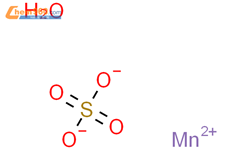硫酸锰 MSDS
基础信息
SECTION 1: Identification of the substance/mixture and of the company/undertaking
Product identifiers
Product name : Manganese(II) sulfate hydrate
Index-No. : 025-003-00-4
REACH No. : A registration number is not available for this substance as the substance
or its uses are exempted from registration, the annual tonnage does not
require a registration or the registration is envisaged for a later
registration deadline.
CAS-No. : 15244-36-7
SECTION 2: Hazards identification
Classification of the substance or mixture
Classification according to Regulation (EC) No 1272/2008
Specific target organ toxicity - repeated exposure (Category 2), H373
Chronic aquatic toxicity (Category 2), H411
For the full text of the H-Statements mentioned in this Section, see Section 16.
Classification according to EU Directives 67/548/EEC or 1999/45/EC
N Dangerous for the R51/53
environment
Xn Harmful R48/20/22
For the full text of the R-phrases mentioned in this Section, see Section 16.
Label elements
Labelling according Regulation (EC) No 1272/2008
Pictogram
Signal word Warning
Hazard statement(s)
May cause damage to organs through prolonged or repeated exposure.
Toxic to aquatic life with long lasting effects.
Precautionary statement(s)
Avoid release to the environment.
Supplemental Hazard none
Statements
Other hazards - none
SECTION 3: Composition/information on ingredients
Substances
Formula : MnO4S · xH2O
Molecular Weight : 151,00 g/mol
CAS-No. : 15244-36-7
EC-No. : 232-089-9
Index-No. : 025-003-00-4
Hazardous ingredients according to Regulation (EC) No 1272/2008
Component Classification Concentration
Manganese sulphate hydrate
CAS-No. 15244-36-7 STOT RE 2; Aquatic Chronic <= 100="">
EC-No. 232-089-9 2; H373, H411
Index-No. 025-003-00-4
Hazardous ingredients according to Directive 1999/45/EC
Component Classification Concentration
Manganese sulphate hydrate
CAS-No. 15244-36-7 Xn, N, R48/20/22 - R51/53 <= 100="">
EC-No. 232-089-9
Index-No. 025-003-00-4
For the full text of the H-Statements and R-Phrases mentioned in this Section, see Section 16
SECTION 4: First aid measures
Description of first aid measures
General advice
Consult a physician. Show this safety data sheet to the doctor in attendance.
If inhaled
If breathed in, move person into fresh air. If not breathing, give artificial respiration. Consult a physician.
In case of skin contact
Wash off with soap and plenty of water. Consult a physician.
In case of eye contact
Flush eyes with water as a precaution.
If swallowed
Never give anything by mouth to an unconscious person. Rinse mouth with water. Consult a physician.
Most important symptoms and effects, both acute and delayed
The most important known symptoms and effects are described in the labelling (see section 2.2) and/or in
section 11
Indication of any immediate medical attention and special treatment needed
no data available
SECTION 5: Firefighting measures
Extinguishing media
Suitable extinguishing media
Use water spray, alcohol-resistant foam, dry chemical or carbon dioxide.
Special hazards arising from the substance or mixture
Sulphur oxides, Manganese/manganese oxides
Advice for firefighters
Wear self contained breathing apparatus for fire fighting if necessary.
Further information
no data available
SECTION 6: Accidental release measures
Personal precautions, protective equipment and emergency procedures
Use personal protective equipment. Avoid dust formation. Avoid breathing vapours, mist or gas. Ensure
adequate ventilation. Evacuate personnel to safe areas. Avoid breathing dust.
For personal protection see section 8.
Environmental precautions
Prevent further leakage or spillage if safe to do so. Do not let product enter drains. Discharge into the
environment must be avoided.
Methods and materials for containment and cleaning up
Pick up and arrange disposal without creating dust. Sweep up and shovel. Keep in suitable, closed
containers for disposal.
Reference to other sections
For disposal see section 13.
SECTION 7: Handling and storage
Precautions for safe handling
Avoid contact with skin and eyes. Avoid formation of dust and aerosols.
Provide appropriate exhaust ventilation at places where dust is formed.
For precautions see section 2.2.
Conditions for safe storage, including any incompatibilities
Store in cool place. Keep container tightly closed in a dry and well-ventilated place.
Recommended storage temperature: 2 - 8 °C
Hygroscopic.
Specific end use(s)
Apart from the uses mentioned in section 1.2 no other specific uses are stipulated
SECTION 8: Exposure controls/personal protection
Control parameters
Components with workplace control parameters
Exposure controls
Appropriate engineering controls
Handle in accordance with good industrial hygiene and safety practice. Wash hands before breaks and
at the end of workday.
Personal protective equipment
Eye/face protection
Safety glasses with side-shields conforming to EN166 Use equipment for eye protection tested
and approved under appropriate government standards such as NIOSH (US) or EN 166(EU).
Skin protection
Handle with gloves. Gloves must be inspected prior to use. Use proper glove removal technique
(without touching glove's outer surface) to avoid skin contact with this product. Dispose of
contaminated gloves after use in accordance with applicable laws and good laboratory practices.
Wash and dry hands.
The selected protective gloves have to satisfy the specifications of EU Directive 89/686/EEC and
the standard EN 374 derived from it.
Full contact
Material: Nitrile rubber
Minimum layer thickness: 0,11 mm
Break through time: 480 min
Splash contact
Material: Nitrile rubber
Minimum layer thickness: 0,11 mm
Break through time: 480 min
test method: EN374
If used in solution, or mixed with other substances, and under conditions which differ from EN 374,
contact the supplier of the CE approved gloves. This recommendation is advisory only and must
be evaluated by an industrial hygienist and safety officer familiar with the specific situation of
anticipated use by our customers. It should not be construed as offering an approval for any
specific use scenario.
Body Protection
Complete suit protecting against chemicals, The type of protective equipment must be selected
according to the concentration and amount of the dangerous substance at the specific workplace.
Respiratory protection
For nuisance exposures use type P95 (US) or type P1 (EU EN 143) particle respirator.For higher
level protection use type OV/AG/P99 (US) or type ABEK-P2 (EU EN 143) respirator cartridges.
Use respirators and components tested and approved under appropriate government standards
such as NIOSH (US) or CEN (EU).
Control of environmental exposure
Prevent further leakage or spillage if safe to do so. Do not let product enter drains. Discharge into
the environment must be avoided.
SECTION 9: Physical and chemical properties
Information on basic physical and chemical properties
a) Appearance Form: solid
b) Odour no data available
c) Odour Threshold no data available
d) pH no data available
e) Melting point/freezing no data available
point
f) Initial boiling point and no data available
boiling range
g) Flash point not applicable
h) Evapouration rate no data available
i) Flammability (solid, gas) no data available
j) Upper/lower no data available
flammability or
explosive limits
k) Vapour pressure no data available
l) Vapour density no data available
m) Relative density 2,090 g/cm3
n) Water solubility no data available
o) Partition coefficient: n- no data available
octanol/water
p) Auto-ignition no data available
temperature
q) Decomposition no data available
temperature
r) Viscosity no data available
s) Explosive properties no data available
t) Oxidizing properties no data available
Other safety information
no data available
SECTION 10: Stability and reactivity
Reactivity
no data available
Chemical stability
Stable under recommended storage conditions.
Possibility of hazardous reactions
no data available
Conditions to avoid
no data available
Incompatible materials
Strong oxidizing agents, Strong acids
Hazardous decomposition products
Other decomposition products - no data available
In the event of fire: see section 5
SECTION 11: Toxicological information
Information on toxicological effects
Acute toxicity
no data available
Skin corrosion/irritation
no data available
Serious eye damage/eye irritation
no data available
Respiratory or skin sensitisation
no data available
Germ cell mutagenicity
no data available
Carcinogenicity
IARC: No component of this product present at levels greater than or equal to 0.1% is identified as
probable, possible or confirmed human carcinogen by IARC.
Reproductive toxicity
no data available
Specific target organ toxicity - single exposure
no data available
Specific target organ toxicity - repeated exposure
May cause damage to organs through prolonged or repeated exposure.
Aspiration hazard
no data available
Additional Information
RTECS: Not available
Men exposed to manganese dusts showed a decrease in fertility. Chronic manganese poisoning primarily
involves the central nervous system. Early symptoms include languor, sleepiness and weakness in the
legs. A stolid mask-like appearance of the face, emotional disturbances such as uncontrollable laughter
and a spastic gait with tendency to fall in walking are findings in more advanced cases. High incidence of
pneumonia has been found in workers exposed to the dust or fume of some manganese compounds.
SECTION 12: Ecological information
Toxicity
no data available
Persistence and degradability
no data available
Bioaccumulative potential
no data available
Mobility in soil
no data available
Results of PBT and vPvB assessment
PBT/vPvB assessment not available as chemical safety assessment not required/not conducted
Other adverse effects
Toxic to aquatic life.
SECTION 13: Disposal considerations
Waste treatment methods
Product
Offer surplus and non-recyclable solutions to a licensed disposal company. Dissolve or mix the material
with a combustible solvent and burn in a chemical incinerator equipped with an afterburner and scrubber.
Contaminated packaging
Dispose of as unused product.
SECTION 14: Transport information
UN number
ADR/RID: 3077 IMDG: 3077 IATA: 3077
UN proper shipping name
ADR/RID: ENVIRONMENTALLY HAZARDOUS SUBSTANCE, SOLID, N.O.S. (Manganese sulphate
hydrate)
IMDG: ENVIRONMENTALLY HAZARDOUS SUBSTANCE, SOLID, N.O.S. (Manganese sulphate
hydrate)
IATA: Environmentally hazardous substance, solid, n.o.s. (Manganese sulphate hydrate)
Transport hazard class(es)
ADR/RID: 9 IMDG: 9 IATA: 9
Packaging group
ADR/RID: III IMDG: III IATA: III
Environmental hazards
ADR/RID: yes IMDG Marine pollutant: yes IATA: yes
Special precautions for user
Further information
EHS-Mark required (ADR 2.2.9.1.10, IMDG code 2.10.3) for single packagings and combination
packagings containing inner packagings with Dangerous Goods > 5L for liquids or > 5kg for solids.
SECTION 15: Regulatory information
This safety datasheet complies with the requirements of Regulation (EC) No. 1907/2006.
Safety, health and environmental regulations/legislation specific for the substance or mixture
no data available
Chemical Safety Assessment
SECTION 16 - ADDITIONAL INFORMATION
N/A
化合物详情(旧版)
硫酸锰物理化学性质
熔点 : 700 C
沸点 : 850 C
敏感性 : Hygroscopic Merck : 14,5739
相对密度(水=1):2.9500
溶解性:易溶于水,不溶于乙醇。
白色至浅红色细小晶体或粉末。在200℃以上开始失去结晶水,280℃时失去大部分结晶水,500℃左右失去全部结晶水。700℃时成熔融物,850℃时开始分解,约在1050℃时完全分解。在27℃以下时溶解度随温度升高而增加,以后随温度上升,溶解度反而逐渐下降,至200℃时仅为0.7%。
硫酸锰不燃,具刺激性。,吸入、摄入或经皮吸收有害,具刺激作用。长期吸入该品粉尘,可引起慢性锰中毒,早期以神经衰弱综合征和神经功能障碍为主,晚期出现震颤麻痹综合征。 对环境有危害,对水体可造成污染。
硫酸锰产品用途
无机工业用于电解锰生产和制备各种锰盐。涂料工业用于生产催干剂和亚麻仁油酸锰等,金属制品的磷化剂。农业上是重要微量元索肥料,也是植物合成叶绿素的催化剂。施以适量的硫酸锰溶液,可使多种经济作物生长良好,增加产量。
硫酸锰拌种预计效果:用硫酸锰溶液拌种可以提高千粒重,增产10%~15%。
拌种方法:播种前先将0.2公斤硫酸锰溶解在0.9公斤清水中,然后拌50公斤麦种.
重要的微量元素肥料之一,可用作基肥,浸种、拌种、追肥以及叶面的喷洒,能促进作物的生长增加产量。在畜牧业和饲料工业中,用作饲料添加剂,可使得畜禽发育良好,并有催肥效果。也是加工油漆、油墨催干剂;荼酸锰溶液的原料;合成脂肪酸时用作催化剂;此外,还可用于造纸、陶瓷、印染、矿石浮选;电解锰的生产原料以及制造其他锰盐的原料。也用于电池、冶炼催化剂、分析试剂、媒染剂、添加剂、药用辅料等。
应用领域
硫酸锰制备方法
主要有以下三种方法:
1.由二氧化锰与硫酸作用而制得。
2MnO2+2H2SO4===2MnSO4+2H2O+O2
2、金属锰与硫酸合成
Mn+H2SO4+===MnSO4+H2
3.生产对苯二酚副产废液含硫酸锰和硫酸铵,废液经石灰乳中和除去杂质,然后加热脱氨的硫酸锰溶液,再经浓缩、结晶、脱水分离、干燥,包装得硫酸锰成品。
硫酸锰化学品安全说明书(MSDS)
危险性概述
健康危害:吸入、摄入或经皮吸收有害,具刺激作用。长期吸入该品粉尘,可引起慢性锰中毒,早期以神经衰弱综合征和神经功能障碍为主,晚期出现震颤麻痹综合征。
环境危害:对环境有危害,对水体可造成污染。
燃爆危险:该品不燃,具刺激性。
急救措施
皮肤接触:脱去污染的衣着,用流动清水冲洗。
眼睛接触:立即提起眼睑,用大量流动清水或生理盐水彻底冲洗至少15分钟。就医。
吸入:迅速脱离现场至空气新鲜处。保持呼吸道通畅。如呼吸困难,给输氧。如呼吸停止,立即进行人工呼吸。就医。
食入:用水漱口,给饮牛奶或蛋清。就医。
消防措施
危险特性:自身不能燃烧。受高热分解放出有毒的气体。
有害燃烧产物:氧化硫。
灭火方法:消防人员必须穿全身防火防毒服,在上风向灭火。灭火时尽可能将容器从火场移至空旷处。然后根据着火原因选择适当灭火剂灭火。
泄漏应急处理
应急处理:隔离泄漏污染区,限制出入。建议应急处理人员戴防尘口罩,穿一般作业工作服。不要直接接触泄漏物。
小量泄漏:避免扬尘,小心扫起,收集运至废物处理场所处置。
大量泄漏:收集回收或运至废物处理场所处置。
操作处置与储存
操作注意事项:密闭操作,局部排风。防止粉尘释放到车间空气中。操作人员必须经过专门培训,严格遵守操作规程。建议操作人员佩戴自吸过滤式防尘口罩,戴化学安全防护眼镜,穿防毒物渗透工作服,戴橡胶手套。避免产生粉尘。避免与酸类接触。配备泄漏应急处理设备。倒空的容器可能残留有害物。
储存注意事项:储存于阴凉、通风的库房。远离火种、热源。防止阳光直射。包装密封。应与酸类分开存放,切忌混储。储区应备有合适的材料收容泄漏物。
储运特性





 GHS08
GHS08
 GHS09
GHS09
 N
N






